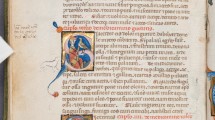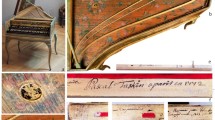Abstract
The increasing interest and debate about the extent of the polychromy of ancient artefacts is generating more attention to the study of the traces of colour remaining on their surfaces. The small amount of these traces lead to a new approach for their characterization in order to limit sampling and hopefully avoiding it. The application of a protocol based on imaging techniques integrated with data obtained from single-spot techniques such as X-ray fluorescence (XRF) and fibre-optic reflectance spectroscopy (FORS) provides high-quality information about the materials. The integrated protocol has been applied in the study of a sarcophagus in San Callisto complex in Rome, and the efficacy of its use is confirmed by the data obtained. The sarcophagus, dating back to fourth-century C.E., is located in Saints Mark, Marcellian and Damasus catacombs. The study was focused on characterization of materials through a multidisciplinary approach with in situ non-invasive techniques (multispectral photography, visible-induced luminescence, XRF and FORS) and microinvasive analytical methods in order to identify the marble’s provenance through a consolidate multianalytical approach (X-ray diffraction, optical microscopy, isotopic ratios). In situ analyses were conducted in critical environment due to the high humidity (RH = 100 %), low temperature (T = 15 °C) and high CO2 levels, all factors representing a challenge for either the operators or the electronic instrumentations. This work is included in a wider research project aimed to enlighten the use of colours on the sculptures in the roman time and to better define the composition of used raw materials.












Similar content being viewed by others
References
D. Tapete, F. Fratini, B. Mazzei, E. Cantisani, C. Riminesi, R. Manganelli Del Fà, B. Sacchi, O.A. Cuzman, L. Scaletti, M.G. Patrizi, P. Tiano, in The Conservation of Subterranean Cultural Heritage, ed. by Saiz- Jimenez (Taylor & Francis Group, London, 2014), p. 51
A.N. Shugar, J.L. Mass, Handheld XRF for Art and Archaeology (Leuven University Press, Leuven, 2013)
M. Galeotti, R. Mazzeo, D. Pinna, Scientific Examination for the Investigation of Paintings: A Handbook for Conservator–Restorers (Centro Di, Florence, 2000)
M. Bacci, Chem. Anal. Ser. 155, 321–362 (2000)
L. Lazzarini, Periodico di Mineralogia LXXIII(3), 113–125 (2004)
C. Gorgoni, L. Lazzarini, P. Pallante, B. Turi, in ASMOSIA V, Interdisciplinary Studies on Ancient Stone, ed. by J.J. Herrmann, N.Herz, R. Newman (Archetype, London, 2002), pp. 115–131
D. Attanasio, M. Brilli, N. Ogle, The Isotopic Signature of Classical Marbles (L’Erma di Bretschneider, Rome, 2006)
A. Amorfini, D. Attanasio, A. Bartelletti, M. Brilli, E. Cantisani, A. Criscuolo (2012) Ante et post Lunam, Archeologia dei marmi apuani, ed. by A. Bartelletti, (Pacini Editore, Ospedaletto, Pisa), pp. 79–95
T. Vitorino, A. Casini, C. Cucci, M.J. Melo, M. Picollo, L. Stefani, in Image and Signal Processing, ed. by A. Elmoataz, O. Lezoray, F. Nouboud, D. Mammas (Springer, Berlin, 2014), pp. 257–264
C. Bisulca, M. Picollo, M. Bacci, D. Kunzelman, in Proceedings of the 9th International Conference on Non-destructive investigations and microanalysis for the diagnostics and conservation of cultural and environmental heritage. http://www.ndt.net/article/art2008/papers/199Bisulca.pdf. Accessed 1 Aug 2015
G. Verri, Anal. Bioanal. Chem. 394, 1011–1021 (2009)
P. Mirti, L. Appolonia, A. Casoli, R.P. Ferrari, E. Laurenti, A. Amisano Canesi, G. Chiari, Spectrochim. Acta A 51(3), 437–446 (1995)
F. Antonelli, S. Columbu, M. Lezzerini, D. Miriello, Appl. Phys. A 115, 1033–1040 (2014)
Pliny the Elder Naturalis Historia, XXV, (Harvard University Press, 1980)
F. Van Keuren, D. Attanasio, J.J. Jr Herrmann, N. Herz, P. Gromet, ed. by J. Elsner, J. Huskinson, (Millennium Studies 2010), pp. 149–187
Acknowledgments
The authors wish to thank Chiara Boschi (IGG CNR) for supplying the isotopic data.
Author information
Authors and Affiliations
Corresponding author
Rights and permissions
About this article
Cite this article
Roberta, I., Susanna, B., Emma, C. et al. An integrated multimethodological approach for characterizing the materials and pigments on a sarcophagus in St. Mark, Marcellian and Damasus catacombs. Appl. Phys. A 121, 1235–1242 (2015). https://doi.org/10.1007/s00339-015-9495-3
Received:
Accepted:
Published:
Issue Date:
DOI: https://doi.org/10.1007/s00339-015-9495-3




